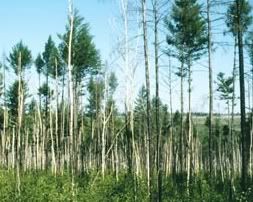Japanese scientists develop hybrid larch trees with 30% greater carbon sink capacity
 The Hokkaido Forest Research Institute and Hokkaido Forest Products Research Institute conducted joint research from 2003 to 2005 on an F1 hybrid of Dahurian Larch (larix gmelinii) to identify families and parent trees with high carbon-fixing potential. The research team discovered that trees grown from certain pollen and seed trees had 30 percent greater carbon storage capacity, compared to typical larch trees. The Dahurian Larch is a species found in Eastern Siberia and Northeastern Asia, where it forms the enormous forests of the taiga. A fast growing tree, the larch is widely used in afforestation and industrial plantation projects.
The Hokkaido Forest Research Institute and Hokkaido Forest Products Research Institute conducted joint research from 2003 to 2005 on an F1 hybrid of Dahurian Larch (larix gmelinii) to identify families and parent trees with high carbon-fixing potential. The research team discovered that trees grown from certain pollen and seed trees had 30 percent greater carbon storage capacity, compared to typical larch trees. The Dahurian Larch is a species found in Eastern Siberia and Northeastern Asia, where it forms the enormous forests of the taiga. A fast growing tree, the larch is widely used in afforestation and industrial plantation projects.The news is important for the bioenergy community because rapidly growing trees with an enhanced carbon storage capacity will be used as 'carbon capture' machines to be used in carbon-negative bioenergy production. The concept is easy to understand: the trees are planted to store large amounts of CO2, after which they are converted into energy (liquid fuels or electricity), while the CO2 they release during the process, is captured and geosequestered. The result is radical carbon-negative energy.
According to scientists, such 'Bio-energy with carbon storage' (BECS) systems are the most radical weapon in the fight against dangerous climate change. If implemented on a global scale, BECS can take us back to pre-industrial atmospheric CO2 levels by mid-century.
Recently, plant biologists developed Eucalyptus trees with a high carbon storage capacity - ideally suited for BECS systems (earlier post).
The Japanese researchers report that the F1 hybrid of Dahurian Larch is the first hybrid generation between Dahurian Larch as seed trees and larch trees as pollen providers. Features of this generation are high resistance to damage from threats such as field mice and weather, and high seedling survival rate. In addition, it has an excellent growth increment like larch, and higher wood density than larch, Sakhalin fir (Abies sachalinensis), and Glehn's spruce (picea glehnii):
 energy :: sustainability ::biomass :: bioenergy :: biofuels :: climate change :: carbon dioxide :: afforestation :: carbon sink :: bio-enerrgy with carbon storage ::
energy :: sustainability ::biomass :: bioenergy :: biofuels :: climate change :: carbon dioxide :: afforestation :: carbon sink :: bio-enerrgy with carbon storage :: The carbon fixing potential is calculated from the amount of carbon stored in standing timber. To enhance cost performance and carbon storage, which requires an improved growth increment and density of timber, the F1 hybrid of Dahurian larch is seen as the best choice among trees used in Hokkaido for afforestation.
Since 2006 private companies have been planting Super F1 seedlings bred from Nakashibetsu 3 and 5 seed trees, and production has been at the rate of about 20,000 seedlings per year as of April 2007. With the aim of increasing production to 300,000 per year, the government is also offering technology transfers for seedling production, targeting 11 seedling producers. The seed and seedling protection group within the Forest Development Division of Hokkaido's Department of Fisheries and Forestry is accepting inquiries on the super F1 seedlings.
References:
Japan for Sustainability: Hybrid Larch Trees Developed with 30% Greater Carbon Sink Capacity - October 2007
Conifers.org: Larix gmelinii, description.
Biopact: Scientists develop low-lignin eucalyptus trees that store more CO2, provide more cellulose for biofuels - September 17, 2007
 --------------
--------------
 Taiwan's Feng Chia University has succeeded in boosting the production of hydrogen from biomass to 15 liters per hour, one of the world's highest biohydrogen production rates, a researcher at the university said Friday. The research team managed to produce hydrogen and carbon dioxide (which can be captured and stored) from the fermentation of different strains of anaerobes in a sugar cane-based liquefied mixture. The highest yield was obtained by the Clostridium bacterium.
Taiwan's Feng Chia University has succeeded in boosting the production of hydrogen from biomass to 15 liters per hour, one of the world's highest biohydrogen production rates, a researcher at the university said Friday. The research team managed to produce hydrogen and carbon dioxide (which can be captured and stored) from the fermentation of different strains of anaerobes in a sugar cane-based liquefied mixture. The highest yield was obtained by the Clostridium bacterium.








2 Comments:
Chestnut and hazelnuts make excellent carbon sinks as well. Other fuel crops can be grown underneath. For more information, check out
a new book at
http://www.permaculture.com/site/node/453
The carbon fixing potential is calculated from the amount of carbon stored in standing timber. To enhance cost performance and carbon storage, which requires an improved growth increment and density of timber, the F1 hybrid of Dahurian larch is seen as the best choice among trees used in Hokkaido for afforestation.
Post a Comment
Links to this post:
Create a Link
<< Home